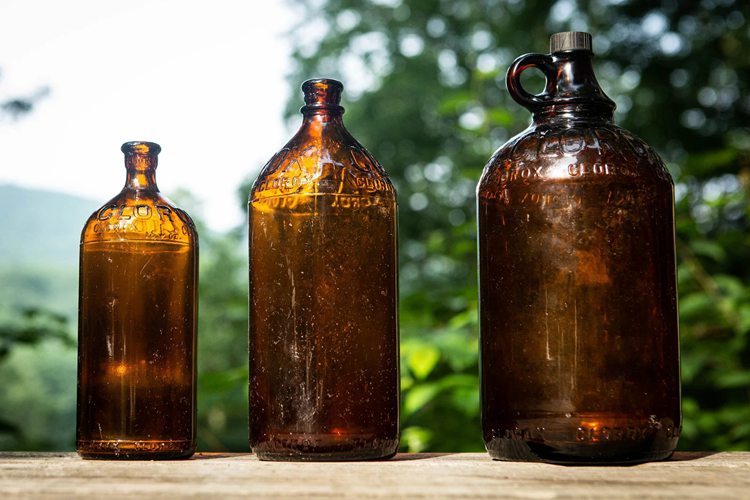Glass bottles have been an integral part of human history, serving as containers for various substances from aromatic oils to potent spirits, and even life-saving medicines. But when did these glass vessels transition from rare, carefully crafted artifacts to everyday household items? Let’s take a journey through time to explore the fascinating evolution of glass bottles.

The Origins of Glassmaking
The history of glass bottles dates back to around 3500 BC in Mesopotamia, where the first glass artifacts were created, initially as beads rather than bottles. By 1500 BC, the first recognizable glass containers began to emerge. These early glass vessels were considered precious commodities, primarily crafted by skilled artisans for storing perfumes and oils. Despite the existence of glass containers, their widespread use did not occur immediately due to the labor-intensive and costly production processes. Over time, various cultures began to explore the potential of glass, with the Egyptians and Romans contributing significantly to its development. The innovations of these early civilizations set the stage for the future proliferation of glass bottles throughout history. As techniques evolved, glass became more accessible, paving the way for its eventual role in everyday life.
Evolution and Innovation in Glass Bottle Production
Although glass containers had been invented, the production of glass bottles saw significant advancement in the 1st century BC with the introduction of glassblowing. This revolutionary technique allowed artisans to produce glass containers more quickly and affordably. The ability to blow glass into various shapes opened new possibilities for creativity and design. However, it wasn’t until the late 19th century that the industrial revolution transformed glass bottle production. The invention of automatic bottle machines in the early 20th century drastically increased production speed and efficiency, making glass bottles accessible to the general public. As production methods improved, the diversity of glass bottle designs expanded, catering to a growing market. This marked a significant turning point in the history of glass packaging, as it transitioned from luxury items to everyday essentials.


The Rise of Glass Bottles in Everyday Life
By the mid-20th century, glass bottles had become a staple in households around the world. They were used for a wide variety of products, including milk, soda, medicines, and cosmetics. One of the key advantages of glass bottles is their non-reactive nature, ensuring that the contents remain pure and uncontaminated. Additionally, consumers appreciated the transparency of glass, which allowed them to see the product inside—an important factor influencing purchasing decisions. Manufacturers capitalized on this by creating uniquely shaped and visually appealing bottles that captured consumer interest. The growing awareness of health and safety also contributed to the preference for glass over other materials. As a result, glass bottles gained popularity not just for their practicality, but also for their aesthetic appeal.
The Modern Era of Glass Bottles
In recent years, the use of glass bottles has faced competition from plastic, yet they remain prevalent in certain industries, particularly beverages. Many consumers continue to favor glass bottles due to their perceived quality and elegance. Environmental concerns regarding plastic waste have sparked renewed interest in glass packaging. As a recyclable and sustainable option, glass bottles are increasingly viewed as a responsible choice. Many brands are embracing glass as an environmentally friendly alternative, responding to consumer demand for sustainable practices. The aesthetic and functional qualities of glass make it a desirable packaging material in today’s market. Moreover, the trend toward eco-consciousness has positioned glass bottles as symbols of quality and sustainability, appealing to a new generation of consumers.

Conclusion
The transformation of glass bottles from rare artisan-crafted items to common household goods illustrates human ingenuity and technological progress. Over thousands of years, glass bottles have evolved alongside our changing needs and preferences, reflecting shifts in taste, technology, and societal norms. Today, glass bottles symbolize both our historical legacy and our commitment to a sustainable future. Therefore, the next time you hold a glass bottle, take a moment to appreciate the remarkable journey it has undergone to reach you. It is not merely a container; it is a vessel of history that connects our past with our future.
Footnotes
If you’re looking for more knowledge of glass bottles, check out the following articles:
– Top 4 Drinking Glass Manufacturers in the U.S
– Top 10 Glass Bottle Manufacturing Companies in India(Latest Updates)
– Top 10 Glass Bottle Manufacturers In The USA
– Why Choose Apple Juice in Small Glass Bottles? A Flavorful Experience
Consult Your Valiant Glass Bottles & Packaging Experts
We help you avoid the pitfalls to deliver the quality and value your glass bottle and jar need, on-time and on-budget.














